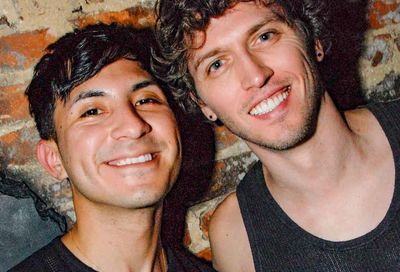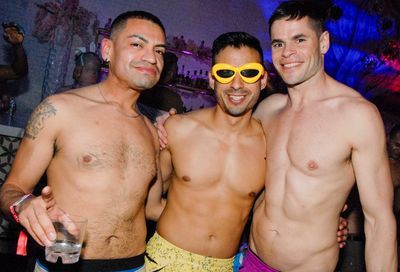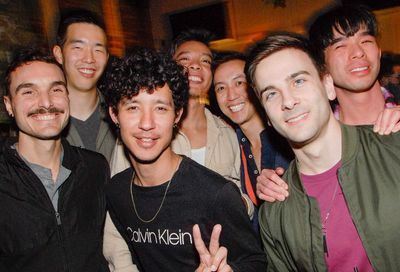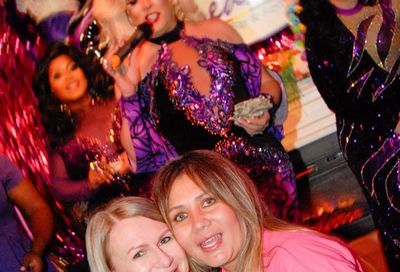Behind the Queens of HBO’s ‘We’re Here’
"We're Here" creators Johnnie Ingram and Stephen Warren bring a familiar reality genre to vibrant, dramatic new life

“Our queens are reality stars,” says Johnnie Ingram. “They’re born from reality television, a thing that is part of pop culture now. And we are bringing this new version of drag, which is finally getting respect as an art form it deserves, to these small towns.”
Ingram, with his husband, Stephen Warren, created and executive produces We’re Here. It’s the couple’s first foray into television production, though they’re no strangers to the creative arts. Warren, a co-chair of GLAAD for several years, has worked as an entertainment lawyer for three decades, while Ingram served as an advertising creative director and has been the driving force behind several notable socially conscious ad campaigns.
Both men hail from small-town upbringings — Ingram from the relatively tiny Morristown, Tennessee, and Warren from the slightly larger Rochester, New York. “When Johnnie and I conceived of the show,” says Warren, “we knew we wanted to feature towns that were small enough so that it feels like a community that’s tight-knit, yet big enough so that there’s enough people to choose from [as candidates for transformation]. We wanted towns that were reflective of the American experience in different ways.” The six-episode HBO series kicks off with Gettysburg, Pennsylvania, and then bounces around the country, going from Branson, Missouri to Twin Falls, Idaho to Shiprock, New Mexico.
“The town is very much a character in the show,” adds Ingram. “The town often is struggling with its own identity. I think that adds a little tension.” Still, says Warren, “we weren’t able to capture on film some of the more subtle aspects of homophobia, transphobia, black-phobia that exist in these places because people aren’t comfortable just saying, ‘Oh, I don’t like you, blah, blah, blah.’ The majority of the people we encountered were very, very friendly. But there were a lot of people who would basically say ‘I can’t come [to the drag show], I’ve got football plans,’ or ‘I’m going to the mall that night.'”
Getting HBO on board with the show turned out to be easier than either man could have envisioned.
“Basically a week after we conceived of the show, I had a lunch scheduled with the head of HBO,” recalls Warren. “We were just having lunch because we’re friends and we do business together. Toward the end, I told him about our idea and he goes, ‘I want it! There’s a woman in New York who runs our unscripted division who has wanted to do something like this for years. Could I send it to her?’ And it was done, just like that.”
“HBO have been great creative partners,” adds Ingram. “It’s been a really, really special experience.” Says Warren, “Nina Rosenstein [the Executive Vice President of HBO Programming] is the most capable and loving executive I have ever encountered — and I have encountered a lot of executives over my career. She has literally trusted us, along with Casey Bloys [President of HBO Programming], and never looked back.”
While We’re Here borrows elements found in many current shows that fall into the makeover genre — most notably the transformation of a person’s sense of self and mindset — it raises the bar considerably. Each episode plays out like a mini-documentary and is as potently dramatic as it is vibrantly entertaining. The rich balance of entertainment and sentiment is achieved with careful precision by director Peter LoGreco and a talented crew of cinematographers and editors. Each episode follows a basic structure, but subtle variation and slight nuances are introduced to keep episodes from feeling cookie-cutter stamped. The series, which deals with three transformations per episode, packs a remarkable amount of narrative into each hour.
It also packs in a remarkable amount of empathy. We’re Here is far from a frivolous makeover series. The level of heartfelt sincerity that emanates from its three glimmering stars — Shangela Laquifa Wadley, Eureka O’Hara, and Bob the Drag Queen — is profound, poignant, and potent. It coaxes deep, eloquent humanity from all three queens, and their compassion and caring grows stronger with each new episode.

“From the beginning, Johnnie and I wanted these three drag queens,” says Warren. “We never talked to any other performers. The most important characteristic we knew we needed to have, in addition to being wildly talented, was empathy. And there are many, many performers — whether you’re a drag performer or not a drag performer — that don’t have that quality. We believed in our hearts that these three had that quality. If they didn’t, the show wouldn’t have worked.”
Very little about We’re Here feels faked or manipulative — the show is defiant in its refusal to create artificially forced resolutions, as in the premiere episode in which one of the subjects desperately longs to reconnect with an estranged, emotionally scarred family member. The ultimate resolution reveals a naturalism rare for this type of program.
Both men concede We’re Here couldn’t exist were it not for RuPaul, who virtually single-handedly transformed how society-at-large views — and responds to — the art of drag.
“We owe an enormous debt to RuPaul and everything RuPaul has accomplished professionally, personally, artistically,” says Warren. “He has created so many stars from his show. And the three performers we have are literal stars. In each of these towns, there are people who freak out when they see them because they’re stars. These are three confident, loving, empathetic, strong people who are bringing their belief in themselves, and the struggles that they went through, to these towns.”
“I don’t think society has seen this side of drag,” says Ingram. “Not only its importance to the LGBTQ community, but how open-armed they are to others. This show is an olive branch [to non-LGBTQ people] so they can see a whole different side of our community.”
We’re Here premieres on April 23 on HBO, and airs weekly on Thursdays at 9 p.m. Visit www.hbo.com.
Support Metro Weekly’s Journalism
These are challenging times for news organizations. And yet it’s crucial we stay active and provide vital resources and information to both our local readers and the world. So won’t you please take a moment and consider supporting Metro Weekly with a membership? For as little as $5 a month, you can help ensure Metro Weekly magazine and MetroWeekly.com remain free, viable resources as we provide the best, most diverse, culturally-resonant LGBTQ coverage in both the D.C. region and around the world. Memberships come with exclusive perks and discounts, your own personal digital delivery of each week’s magazine (and an archive), access to our Member's Lounge when it launches this fall, and exclusive members-only items like Metro Weekly Membership Mugs and Tote Bags! Check out all our membership levels here and please join us today!
























